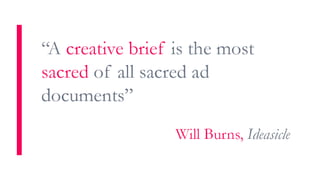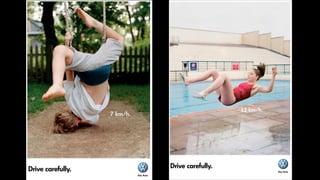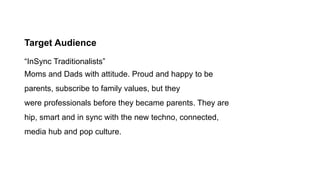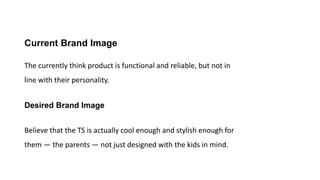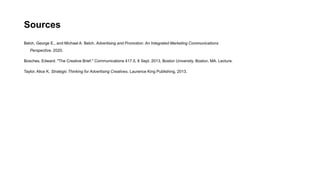The creative brief (spring 2021)
- 1. understanding the creative brief Marshall Pickard, Communications Professor: COMM 340
- 4. What is the creative brief? It is a blueprint, a guide, even a source of inspiration. It details our objectives, audience/community, message or utility, the context in which we’ll engage, timing and budget. In short, the what, who, where, when.
- 5. The brief is the what we are doing. The creative is the how.
- 11. 9 Key Elements of a Creative Brief 1. Basic problem or issue the communication must address or solve. 2. Communication objectives. 3. Target audience. 4. Insights to drive creative work. 5. Key benefits or major selling idea to communicate. 6. Reason to believe/supporting information. 7. Tone and manner/brand personality. 8. Deliverables (what is needed and when). 9. Measures of success (should be tied back to objectives). FIGURE 8-3: Key Elements of a Creative Brief (p. 74) Belch, George E., and Michael A. Belch. Advertising and Promotion: An Integrated Marketing Communications Perspective. 2020.
- 12. 11 Key Elements of a Creative Brief (Taylor) 1. Product or Service (What) 2. Advertising Objective (Problem) 3. Target Market (Who) 4. Strategy (How) 5. Proposition (Hook) 6. Support (Why?) 7. Competition 8. Mandatory Elements (Legal, logo, brand styles) 9. Tone 10. Response 11. Media Requirements (Where) Taylor, Alice K. Strategic Thinking for Advertising Creatives. Laurence King Publishing, 2013
- 13. The elements of your creative brief What you are creating as your blueprint and the roadmap for you and your client to create an effective ad campaign. Our Service-Learning Project (SLP) will use as our “Agency” guidelines for our creative brief. This is our template.
- 14. 1. Product or Service Summary What is the product or service you are selling? What is the history? How is your client seen or perceived in the marketplace?
- 15. 2. Advertising Objective What is the problem you are trying to solve or the challenge you need to overcome? Describe in a few, specific sentences. Need to introduce a new product and get attention. Want to reposition a product so that a new user will consider it. Want to get current users to consume more. Etc.
- 16. An effective objective 1. To sell more seats in First and Business class. 2. To sell more seats in First and Business class letting these prospective passengers know that American Airlines offers power-ports. 3. To sell more seats in First and Business class letting these prospective passengers know that flying with American Airlines enables you to better control and make good use of your time.
- 17. 3. Target Audience (TA) or Target Market (TM) With whom are you engaging? Who is the primary focus of your advertising? Demographic – age, sex, income, marital status (physical). Psychographic – interests, aspirations, lifestyle, habits, beliefs, opinions (attitudes & values).
- 18. 4. Key Features and Benefits What are the benefits of your product or service? How do they appeal to the Target Audience? What makes you unique? Major selling points? How can you solve the TM/TA problem?
- 19. 5. Current Brand Image What do they think about our brand now? How are we perceived by the market? How are you viewed? How does our audience see us? What adjectives describe us?
- 20. 6. Desired Brand Image What do you want them to believe or to do? Do we need to change perception, opinion, frame of reference? What outcome do you wish to achieve?
- 21. 7. Direct Competition Who is fighting for your TA attentions? Who are you directly competing against? How do they advertise? What is their market position?
- 22. 8. Indirect Competition What are the alternatives? How do they solve the problem? How do they appeal to our TA? Are there sociological or economic factors?
- 23. 9. The Deliverables Where will the advertising appear? What media will you use? Where and when will the TA see the advertising? What does the client suggest? What does your research suggest? What is best?
- 24. 10. The Strategic Message What’s the hook? What’s the offer? How will you strike a chord? How do you bring them in?
- 25. Most often the creative comes out of the driving brand idea (message)... The driving brand idea. The single thing you are going to say or do.
- 28. Low speed crashes hurt more than you realize.
- 30. Charmin’ makes your bathroom experience more.
- 32. But, the creative idea can come from other parts of the brief, too.
- 33. Advertising Objective (Toyota Sienna Mini-van) Overcome lost market share. Make the TS a purchase that is not embarrassing for younger parents. Significantly increase consideration among target audience.
- 34. Target Audience “InSync Traditionalists” Moms and Dads with attitude. Proud and happy to be parents, subscribe to family values, but they were professionals before they became parents. They are hip, smart and in sync with the new techno, connected, media hub and pop culture.
- 35. Current Brand Image The currently think product is functional and reliable, but not in line with their personality. Desired Brand Image Believe that the TS is actually cool enough and stylish enough for them — the parents — not just designed with the kids in mind.
- 36. Our Insights Today’s young parents are no longer isolated at home with babies and toddlers. They can and do reach out to the broader world – almost constantly. Social media is their lifeline and sharing information is a consistent activity throughout their day. We knew from this that we could enlist them to become our collaborators – not only in distributing our message but in developing it as well. Because this target is so consistently and actively on Facebook and YouTube, we kept our ear to the virtual ground. We picked up on what they were saying so we could elevate the fun for the follow-up launch of the even sportier SE grade.
- 38. Questions? Marshall Pickard, Communications Professor: COMM 340
- 39. Sources Belch, George E., and Michael A. Belch. Advertising and Promotion: An Integrated Marketing Communications Perspective. 2020. Bosches, Edward. "The Creative Brief." Communications 417.5, 8 Sept. 2013, Boston University. Boston, MA. Lecture. Taylor, Alice K. Strategic Thinking for Advertising Creatives. Laurence King Publishing, 2013.



